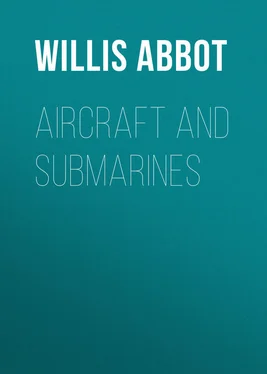Willis Abbot - Aircraft and Submarines
Здесь есть возможность читать онлайн «Willis Abbot - Aircraft and Submarines» — ознакомительный отрывок электронной книги совершенно бесплатно, а после прочтения отрывка купить полную версию. В некоторых случаях можно слушать аудио, скачать через торрент в формате fb2 и присутствует краткое содержание. Жанр: foreign_antique, foreign_prose, на английском языке. Описание произведения, (предисловие) а так же отзывы посетителей доступны на портале библиотеки ЛибКат.
- Название:Aircraft and Submarines
- Автор:
- Жанр:
- Год:неизвестен
- ISBN:нет данных
- Рейтинг книги:4 / 5. Голосов: 1
-
Избранное:Добавить в избранное
- Отзывы:
-
Ваша оценка:
- 80
- 1
- 2
- 3
- 4
- 5
Aircraft and Submarines: краткое содержание, описание и аннотация
Предлагаем к чтению аннотацию, описание, краткое содержание или предисловие (зависит от того, что написал сам автор книги «Aircraft and Submarines»). Если вы не нашли необходимую информацию о книге — напишите в комментариях, мы постараемся отыскать её.
Aircraft and Submarines — читать онлайн ознакомительный отрывок
Ниже представлен текст книги, разбитый по страницам. Система сохранения места последней прочитанной страницы, позволяет с удобством читать онлайн бесплатно книгу «Aircraft and Submarines», без необходимости каждый раз заново искать на чём Вы остановились. Поставьте закладку, и сможете в любой момент перейти на страницу, на которой закончили чтение.
Интервал:
Закладка:
Low steep hills down the sides of which they could run and at the proper moment throw themselves upon their glider; a sandy soil which would at least lessen the shock of a tumble; and a vicinage in which winds of eighteen miles an hour or more is the normal atmospheric state were the conditions they sought. These they found at a little hamlet called Kitty-Hawk on the coast of North Carolina. There for uncounted centuries the tossing Atlantic had been throwing up its snowy sand upon the shore, and the steady wind had caught it up, piled it in windrows, rolled it up into towering hills, or carried it over into the dunes which extended far inland. It was a lonely spot, and there secure from observation the Wrights pitched their camp. For them it was a midsummer's holiday. Not at first did they decide to make aviation not a sport but a profession. To their camp came visitors interested in the same study, among them Chanute, a well-known experimenter, and some of his associates. They had thought to give hours at a time to actual flight. When they closed their first season, they found that all their time spent in actual flight footed up less than an hour. Lilienthal, despite all he accomplished, estimated that he, up to a short time before his death, spent only about five hours actually in the air. In that early day of experimentation a glide covering one hundred feet, and consuming eight or ten seconds, was counted a triumph.
But the season was by no means wasted. Indeed such was the estimate that the Wrights put upon it that they folded their tents determined that when they returned the year following it would be as professionals, not amateurs. They were confident of their ability to build machines that would fly, though up to that time they had never mounted a motor on their aircraft.
In the clear hot air of a North Carolina midsummer the Wrights used to lie on their backs studying through glasses the methods of flight of the great buzzards – filthy scavenger birds which none the less soaring high aloft against a blue sky are pictures of dignity and grace.
Bald eagles, ospreys, hawks, and buzzards give us daily exhibitions of their powers [wrote Wilbur Wright]. The buzzards were the most numerous, and were the most persistent soarers. They apparently never flapped except when it was absolutely necessary, while the eagles and hawks usually soared only when they were at leisure. Two methods of soaring were employed. When the weather was cold and damp and the wind strong the buzzards would be seen soaring back and forth along the hills or at the edge of a clump of trees. They were evidently taking advantage of the current of air flowing upward over these obstructions. On such days they were often utterly unable to soar, except in these special places. But on warm clear days when the wind was light they would be seen high in the air soaring in great circles. Usually, however, it seemed to be necessary to reach a height of several hundred feet by flapping before this style of soaring became possible. Frequently a great number of them would begin circling in one spot, rising together higher and higher till finally they would disperse, each gliding off in whatever direction it wished to go. At such times other buzzards only a short distance away found it necessary to flap frequently in order to maintain themselves. But when they reached a point beneath the circling flock they began to rise on motionless wings. This seemed to indicate that rising columns of air do not exist everywhere, but that the birds must find them. They evidently watch each other and when one finds a rising current the others quickly make their way to it. One day when scarce a breath of wind was stirring on the ground we noticed two bald eagles sailing in circling sweeps at a height of probably five hundred feet. After a time our attention was attracted to the flashing of some object considerably lower down. Examination with a field-glass proved it to be a feather which one of the birds had evidently cast. As it seemed apparent that it would come to earth only a short distance away, some of our party started to get it. But in a little while it was noted that the feather was no longer falling, but on the contrary was rising rapidly. It finally went out of sight upward. It apparently was drawn into the same current in which the eagles were soaring and was carried up like the birds.
It was by such painstaking methods as these, coupled with the mathematical reduction of the fruits of such observations to terms of angles and supporting planes, that the Wrights gradually perfected their machine. The first airplane to which they fitted a motor and which actually flew has been widely exhibited in the United States, and is to find final repose in some public museum. Study it as you will you can find little resemblance in those rectangular rigid planes to the wings of a bird. But it was built according to deductions drawn from natural flight.
The method of progress in these preliminary experiments was, by repeated tests, to determine what form of airplane, and of what proportions, would best support a man. It was evident that for free and continuous flight it must be able to carry not only the pilot, but an engine and a store of fuel as well. Having, as they thought, determined these conditions the Wrights essayed their first flight at their home near Dayton, Ohio. It was a cold December day in 1903. The first flight, with motor and all, lasted twelve seconds; the fourth fifty-nine seconds. The handful of people who came out to witness the marvel went home jeering. In the spring of the next year a new flight was announced near Dayton. The newspapers had been asked to send reporters. A crowd of perhaps fifty persons had gathered. Again fate was hostile. The engine worked badly and the airplane refused to rise. The crowd dispersed and the newspapermen, returning the next day, met only with another disappointment.
These repeated failures in public exhibitions resulted in creating general indifference to the real progress that the Wrights were making in solving the flight problem. While the gliding experiments at Kitty-Hawk were furnishing the data for the plans on which the tens of thousands of airplanes used in the European war were afterwards built, no American newspaper was sufficiently interested to send representatives to the spot. The people of the United States were supremely indifferent. Perhaps this was due to the fact that superficially regarded the machine the Wrights were trying to perfect gave promise of usefulness only in war or in sport. We are not either a warlike or a sporting people. Ready enough to adopt a new device which seems adapted for utilitarian purposes, as is shown by the rapid multiplication of automobiles, we leave sport to our professional ball players, and our military equipment to luck.
So after continued experimental flights in the open fields near Dayton had convinced them that the practical weaknesses in their machine had been eliminated, the Wrights packed up their flyer and went to France. Before so doing they tried to get encouragement from the United States Government, but failed. Neither the government nor any rich American was willing to share the cost of further experiments. All that had been done was at their own cost, both in time and money. In France, whither they went in 1908, they had no coldness to complain of. It was then the golden day of aviation in the land which always afforded to the Knights of the Air their warmest welcome and their most liberal support. Two years had elapsed since Santos-Dumont, turning from dirigibles to 'planes, had made a flight of 238 yards. This the Wrights had at the time excelled at home but without attracting attention. France on the contrary went mad with enthusiasm, and claimed for the Brazilian the honour of first demonstrating the possibility of flight in a heavier-than-air machine. England, like the United States, was cold, clinging to the balloon long after all other nations had abandoned it. But France welcomed the Wrights with enthusiasm. They found rivals a-plenty in their field of effort. Santos-Dumont, Bleriot, Farman, Latham were all flying with airplanes, but with models radically different from that of the American brothers. Nevertheless the latter made an instant success.
Читать дальшеИнтервал:
Закладка:
Похожие книги на «Aircraft and Submarines»
Представляем Вашему вниманию похожие книги на «Aircraft and Submarines» списком для выбора. Мы отобрали схожую по названию и смыслу литературу в надежде предоставить читателям больше вариантов отыскать новые, интересные, ещё непрочитанные произведения.
Обсуждение, отзывы о книге «Aircraft and Submarines» и просто собственные мнения читателей. Оставьте ваши комментарии, напишите, что Вы думаете о произведении, его смысле или главных героях. Укажите что конкретно понравилось, а что нет, и почему Вы так считаете.












